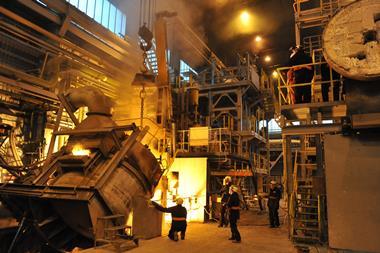Thermoset plastic can be reworked like its thermoplastic cousin thanks to its reversible crosslinks
French scientists have created a new lightweight plastic that is as strong and stable as other thermoset materials such as Bakelite, yet can be easily reworked and reshaped when heated. The team suggests the material could be used in many applications, from aviation to electronics, while being recyclable and repairable.

Typically, the atoms in thermoset polymers are permanently crosslinked giving them excellent mechanical properties and solvent resistance. However, unlike thermoplastics, which can be repeatedly melted and moulded, thermosets remain fixed in shape once made and cannot be reprocessed.
Now, Damien Montarnal and colleagues led by Ludwik Leibler at the Industrial Physics and Chemistry Higher Educational Institution in Paris have created a thermosetting material that can be repeatedly reshaped like a silica glass using heat. According to the team the reworked material retains the mechanical properties of the original material.
’These materials are thermoset organic resins but they can be worked by techniques similar to blowing and smithing hitherto available solely for metals and glass,’ says Leibler. ’Compared with metal and glass, they bring lightness, ease of implementation and a wide range of hardness and extensibility. Compared to other thermoset organic resins, they can be reshaped, recycled, repaired and still present solvent resistance and good mechanical properties.’
The material was made like a conventional epoxy resin by mixing a liquid resin, hardener and catalyst and then heating it between two hot plates. After complete curing, the material was cut and shaped in an oven or by using a heat gun. By applying sufficient heat, the material can be reshaped and remoulded. The team also demonstrated that it can be ground down into a powder and then remoulded or injected.
It works because the material is able to flow when heated thanks to reversible exchange reactions by transesterification. These allow some of the crosslinks in the molecular network to change the topology of the material without breaking bonds in the molecular network hence maintaining its integrity as a solid and preventing depolymerisation. During cooling exchange reactions become so sluggish that the network appears to be a solid just like silica glass.
’By implementing the concept of crosslink exchange they have created a novel polymer network with unique capabilities,’ comments Christopher Bowman who investigates synthetic polymers at the University of Colorado in Boulder, US. ’It is similar to other covalent adaptable networks that exist but implements a distinct reaction mechanism that utilises a non-radical mediated exchange reaction to enable the adaptation process. This reaction keeps the material in its polymer state but allows for reprocessing and recycling.’ Bowman expects the principle applications will be in healable and recyclable composite materials.
’Possible applications include coatings, furniture, propellers and, more generally, any complex part in the fields where one wishes to combine lightness with mechanical and chemical resistance such as aviation, automotive, portable electronics, etc,’ says Leibler. He suggests the new material, once reinforced by fibres, might even compete with metals in the most demanding applications.
James Urquhart
References
D Montarnal et al, 2011, DOI: 10.1126/science.1212648






No comments yet